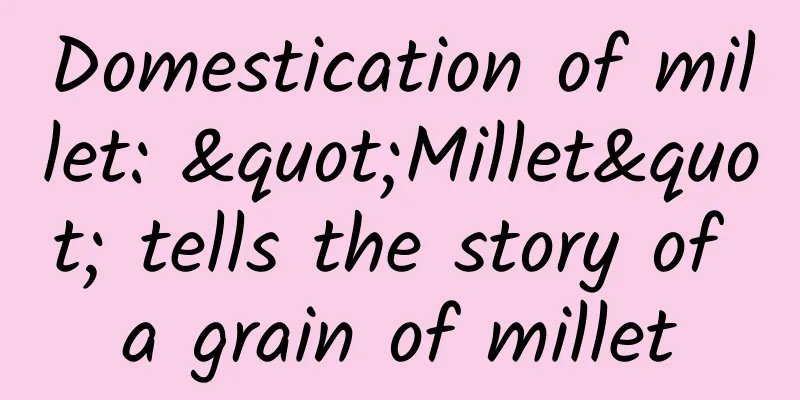Domestication of millet: "Millet" tells the story of a grain of millet

|
Millet is the most important food crop in ancient China, ranking first among the five grains. In the long era of agricultural civilization, the biggest dream of the Chinese people was peace and prosperity in the country and a good harvest of grains. Among the five grains, millet and sorghum were the first to be familiar to the Chinese ancestors. The "Ji" in Jiangshan Sheji comes from millet, and then refers to the grain god in charge of grain abundance. In the prehistoric Neolithic Age, the ancestors of the Chinese people had already begun to plant and eat millet and sorghum on a large scale. After thousands of years of artificial breeding and selection, China has cultivated a variety of millet crop varieties. The earliest wine and vinegar in China were brewed with millet. Thousands of years before wheat was introduced into China and rice crossed the Yangtze River into the Yellow River Basin, it was the native crops with husks such as millet and sorghum that nurtured the Chinese nation and nourished the Chinese civilization, eventually making the Chinese civilization one of the most brilliant ancient civilizations of the same era, and it has been splendid for thousands of years. It can be said that among various crops, millet has the longest and richest cultural connotation. The millet culture, a "gold mine" sleeping underground, is waiting for people to dig. Millet is commonly known as millet in northern China. After the seeds are shelled, they are called millet. Millet is drought-resistant and barren-resistant. To produce the same weight of grain, millet requires only 1/3 of corn, 1/2 of wheat, and 1/5 of rice. But today, millet is not the staple food of Chinese people. However, surprisingly, millet can be seen in almost all provinces of China. When did Chinese people start to grow millet? Why is this marginalized and minor crop so widely distributed in China? What secrets are hidden in it? The plow, invented in the Western Han Dynasty in the 2nd century BC, is the ancestor of the modern seed drill. The iron plow, ox-drawn plow and the plow are important contributions made by China to world agriculture. These great inventions were all born with millet farming. Yinxu unearthed the world-famous oracle bone script. The oracle bone script has a history of more than 3,600 years. In the oracle bone script, the character "禾" is the whole picture of a millet. And the character "米" in the oracle bone script looks like a grain ear full of grains. In 100 AD, the "Shuowen Jiezi" compiled by Xu Shen, a writer of the Eastern Han Dynasty, is the oldest dictionary in China. It gives a clearer interpretation of the character "米": 米, millet, is the shape of the grain. It means: 米 is the seed of millet, and the shape of the character looks like the shape of a grain. All these signs are revealing some secrets, that is, the influence of millet on China seems to be far beyond the imagination of ordinary people. In fact, there are as many as 50 or 60 unearthed remains of millet in China, distributed in more than a dozen provinces (autonomous regions) such as Hebei Province, Shaanxi Province, Henan Province, Gansu Province, and Inner Mongolia Autonomous Region, and most of them are concentrated in the Yellow River Basin. The Yellow River Basin is the origin center of Chinese civilization. Why did millet become the first choice for cultivation by Chinese ancestors? Is it native to China, or was it spread from abroad? The millet cultivated in my country was not introduced from abroad, but was domesticated from Chinese green foxtail grass. The Chinese ancestors discovered the natural variation of foxtail grass, and selected individuals with variations that are beneficial to humans, such as "large ears, no falling grains, and few tillers", and carried out special breeding to stably pass on these excellent traits. There is a big difference between foxtail grass and millet. Millet plants are tall, have few tillers, do not drop grains, have large grains, and have a lot of fragrance. The domestication of foxtail grass to today's millet has undergone thousands or even tens of thousands of years of change. It has gradually become a plant that does not drop grains. This domestication process has changed from many tillers to few tillers. In fact, it is a process of constant domestication and improvement. It has achieved a process from foxtail grass to farm varieties, and then to today's cultivated varieties. Image source: "The Story of a Grain of Millet" |
>>: Here's everything you need to know about ski jumping
Recommend
iPhone finally supports third-party apps? iOS 14.7 Beta 5 leaks
Recently, Apple officially pushed the iOS 14.7 an...
What? Not only is there no New Year's Eve this year, but even the Nian beast is gone?
Whenever the Lunar New Year approaches, the legen...
After doing nucleic acid tests so many times, I finally know where to poke!
Addendum 1: Because I have to queue up for nuclei...
Event Operation: How to conduct a live broadcast sharing that can attract 10,000+ users?
Nowadays, the cost of acquiring customers for onl...
Are these 9.9 yuan free shipping headphones really usable? Will they damage your hearing?
On many shopping apps, when you search for "...
Introduction to the Tik Tok information flow brand advertising matrix!
Douyin’s brand advertising product matrix: Douyin...
China Unicom responds to the "eight pitfalls": Satisfactory solutions will be provided within a limited time
On the evening of December 13th, Beijing time, Ch...
"Weibo Marketing Traffic Generation System 3.0" builds a traffic generation system from 0 to 1, with a full practical demonstration
Training course content: Build a drainage system ...
National Hypertension Day | You must not know these 5 misunderstandings about lowering blood pressure
Hypertension is the most important risk factor fo...
How to replace the official iPhone battery for 218 yuan? Here is a complete and practical guide
On December 29, 2017, Apple apologized to users f...
The other side of the layoff wave: Don’t want to “roll” anymore, want to be “N+1”
Yuan Dian clearly remembers that the number of pe...
Google launches Android TV: voice control, rich games
The 2014 Google Developer Conference (Googl I/O) k...
5 key points for Tik Tok monetization!
As one of the short video platforms with the larg...
Halfway through 2021, have internet celebrity brands collectively “collapsed”?
The excitement in the new consumer track reached ...
Mobei Class Foreign Trade SEO Promotion Google SEO (Google SEO) Tutorial (2-7 Periods 10-11 Periods) Value 3490 yuan
The fifth session of Mobei Kefan Foreign Trade Go...









